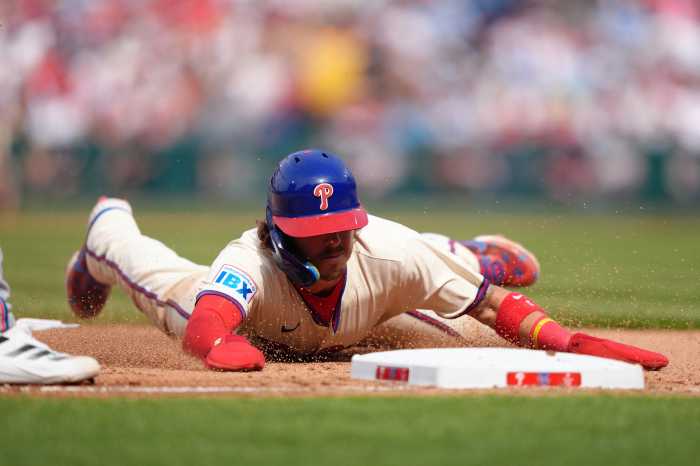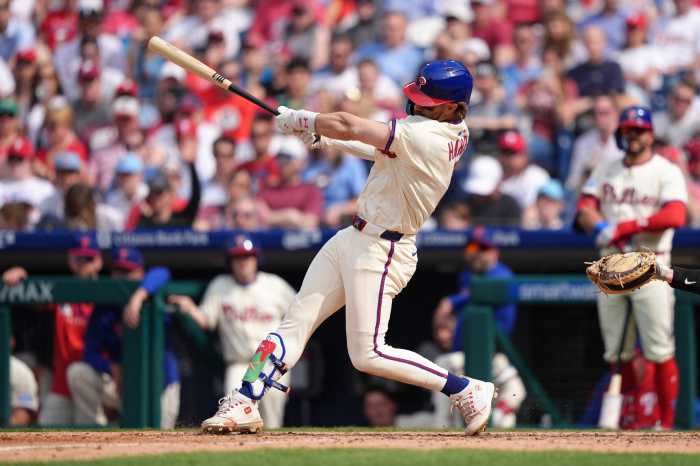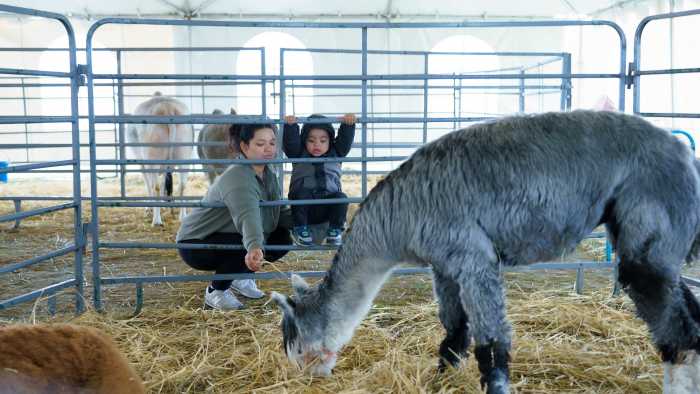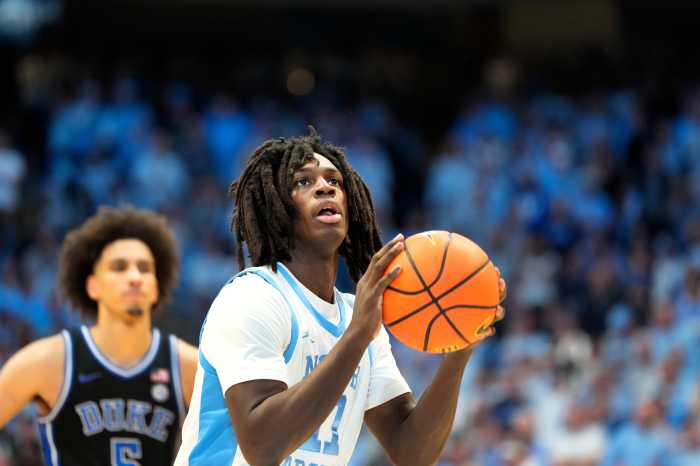It has been quite a journey for Philadelphia Phillies fans in the first half of the 2024 season.
The club has sported one of the best records in all of Major League Baseball, building that success from an incredible starting rotation, and on the backs of offensive outbreaks. The Phillies have a chance to send half their roster to the 2024 All-Star game due to the spoils of their hot start.
One of the few players on the roster who is not enjoying as much individual success as team success is Bryson Stott. The third-year infielder for the Phillies hasn’t quite gotten off to the start he is looking for. Stott is batting .243 in 78 games this season. A drop off from his .280 mark in 2023, where he was hitting around the .300 for a large portion of the season.
Bryson Stott’s best feature has always been his ability to work counts. Making the opposing pitcher work hard, and waiting for a mistake pitch or a walk has been an elite aspect of Stott’s game. While he is still amongst the best in baseball at this trait, the rest of his offensive production has not followed suit.
The Difference in Performance
Using Baseball Savant as a reference, I dove into the numbers between Bryson Stott in both 2023 and 2024.
One of the major categories that jumped out to me was the difference in walk percentage. Bryson is walking at a more efficient rate in 2024 than he did in 2023, making a 5.8 percent jump. He has walked 36 times this season. In all of 2023, Stott walked just 39 times, which shows his growth at the plate.
One of the metrics that it appears he has taken a step back is his exit velocity. Balls are coming off his bat 1.7 mph slower. While that doesn’t seem like a big deal, it drops him 13 percentiles according to the metrics. This pairs with his xBA (expected batting average), which has dropped 15 points in 2024 from the mark he set in 2023.
To simplify, Bryson Stott is walking more efficiently, but not hitting the ball as hard anymore. This has led to a decrease in hits and an overall drop in offensive numbers.
The Eye Test
Many baseball fans are not big proponents of “new-school analytics” in Major League Baseball. Some fans like to resort to the eye test, something they can base their opinions on. Indeed, stats don’t always tell the full story and there is value to watching the actual games be played.
With that being said, I compiled the following mashup of Bryson Stott’s at-bats over the last couple of series for the Phillies.
**NOTE: I am not a professional hitting coach and the following are observations from my experiences in baseball.
Stott’s 1st AB
The first at-bat in the montage is Bryson’s RBI Sac-Fly in Friday’s game against the Marlins.
In a full count, the Phillies’ second baseman hit a deep enough fly ball to left field. This allowed Johan Rojas to tag up from third, giving the Phillies a 2-0 lead.
What you see on this swing is Bryson using his 2-strike approach. He is focused more on making contact and putting the ball in play, rather than trying to hit a home run. He does not step towards the ball but rather shifts his weight through his hips.
The pitch he hits ends up being below the zone, forcing him to reach to make contact. By reaching, he loses power in his swing due to being off-balanced. Think of picking up a box, when you bend with your knees, it’s a position of strength. When you bend over and lift with your back, you lose strength and leave yourself vulnerable.
A positive from the swing however is that Bryson keeps his hands back. This allows him to drive the ball to left field in the air, a key element in the at-bat. Getting the ball in the air gives Johan Rojas a chance to tag up and score, which he does.
This example shows a flaw in the swing (having to reach) but how keeping his hands behind the ball helps get his goal accomplished. Overall, this is a positive result.
Stott’s 2nd AB
The second at-bat on the list is from a game in Detroit against the Tigers.
In this instance, there is a runner at first with nobody out. Bryson had worked a full count and the Phillies had a 5-1 lead at this stage in the game. Stott gets a pitch up and away from the Tiger’s pitcher in a 1-0 count.
Stott poked the ball the other way and avoided a double play with his speed. While it was the right move to take an outside pitch the opposite way, Bryson does not get enough on the ball. Hitting the ball off the end of the bat gives the defense a routine play which nearly allowed them to turn two.
With there being no step in his swing, outside pitches are going to cause Bryson to reach out for them. A step would allow him to get the barrel further out in the zone but because he opts to keep his feet planted, he opens himself up to that outside pitch. The pitcher gets exactly what he is looking for, a weak ground ball hit in the infield.
This example shows that while Bryson is right to take the opposite pitch away, he needs to get more of the barrel on the ball. Reaching for it eliminates power on the swing and without the step, he cannot drum enough force to launch the ball. Overall this was a bad at-bat by Stott’s standards.
Stott’s 3rd AB
We stay in Detroit for this third at-bat. In an 8-1 game, Stott is leading off the 9th inning for the Phillies.
With a 1-0 count, Bryson takes a 1-0 pitch that comes inside from a lefty and shoots it opposite field. He gets a base hit and leads the inning off with a single. This was a productive at-bat despite not hitting the ball very hard.
It was a good AB, but on an inside pitch, it first appears that he was late. This would explain why he does not pull the ball and instead goes opposite field. It’s a good sign to see he is trying to go opposite field when hitting, but on an inside pitch such as the one we see here, that is a classic pitch to turn on. This allows your full body weight to get around on it, which usually leads to higher exit velocity.
The best-case scenario here would be for Bryson Stott to turn on the pitch and hit it hard on the right side of the field. He gets a hit in this situation and that is never a bad thing but it only goes down as a scorcher in the books.
Keeping his hands in and sending the ball out for a hit was a positive. But being quick to the ball and turning on an inside pitch did not take place. Still, you can’t be upset with a hit. It’s a positive at-bat but shows how there could’ve been some improvement.
Overall Observations
If Bryson Stott is going to get back on track offensively, there are two aspects of hitting that he will have to make adjustments to.
The first adjustment is not something that you can fix overnight, but his timing at the plate has room for growth. Allowing the ball to travel deeper in the zone leads to more balls being barrelled. The harder you hit the ball does not always guarantee a hit, but it does often lead to extra base hits. Bryson has not homered since May 18th, which is a 36-game streak without the long ball.
The second area that he can work on would be his swing path. Bryson seems to be hitting the ball off the end of the bat quite frequently and he tends to roll over on balls. Like Johan Rojas, Stott’s swing could be shortened. Being quicker to the ball would help with both his timing and barreling.
We have seen the Phillies’ second baseman thrive in the big leagues. His 2023 season was a step in the right direction, with 2024 almost being a step backward. Bryson Stott has it in him and he is just a couple of tweaks away from a hot streak. With injuries holding back some key contributors, now might be the right time for him to go on a heater.
Again, I am not a professional hitting coach, so take this with a grain of salt. But when watching his at-bats in the upcoming series with the Cubs and Braves, keep these concepts in mind.
Photo Credit: (AP Photo/Matt Slocum)





























